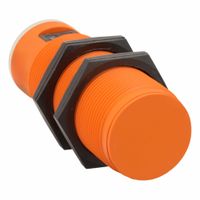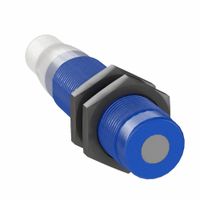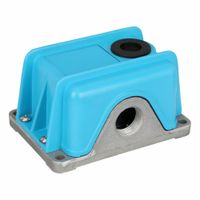Call +(254) 703 030 000 / 751 483 999 / 721 704 777
- Home
- Electrical
- Industrial Controls Automation And Machine Safety
- Proximity Motion Vision Sensors
.....Read More
Frequently Asked Questions
What are the differences between proximity sensors and motion sensors?
Proximity sensors and motion sensors are both used to detect the presence or movement of objects, but they operate differently and serve distinct purposes.
Proximity sensors detect the presence or absence of an object within a certain range without physical contact. They are commonly used in applications like touchless faucets, smartphones, and industrial automation. Proximity sensors can be based on various technologies, including infrared, ultrasonic, capacitive, and inductive. Infrared sensors use light to detect objects, ultrasonic sensors use sound waves, capacitive sensors detect changes in capacitance, and inductive sensors detect metallic objects through electromagnetic fields. These sensors are typically used for short-range detection and are effective in environments where physical contact is undesirable or impractical.
Motion sensors, on the other hand, detect movement within a specific area. They are widely used in security systems, automatic lighting, and smart home devices. Motion sensors can be based on technologies such as passive infrared (PIR), microwave, and ultrasonic. PIR sensors detect changes in infrared radiation caused by moving objects, typically humans or animals. Microwave sensors emit microwaves and detect changes in the reflected waves caused by movement. Ultrasonic motion sensors, similar to their proximity counterparts, use sound waves to detect motion. Motion sensors are generally used for larger areas and can detect movement over longer distances compared to proximity sensors.
In summary, the primary difference lies in their function: proximity sensors detect the presence of objects within a short range, while motion sensors detect movement over a larger area. The choice between them depends on the specific application requirements, such as range, environment, and the type of object or movement to be detected.
How do photoelectric proximity sensors work?
Photoelectric proximity sensors operate by using a light transmitter and a receiver to detect the presence or absence of an object. These sensors are based on the principle of detecting changes in light intensity.
1. **Components**: The primary components include a light source (usually an LED), a photodetector (such as a photodiode or phototransistor), and a signal processor. The light source emits a beam of light, which can be visible or infrared.
2. **Types**: There are three main types of photoelectric sensors:
- **Through-beam**: The transmitter and receiver are placed opposite each other. An object is detected when it interrupts the light beam.
- **Retro-reflective**: The transmitter and receiver are housed together, and a reflector is placed opposite them. The sensor detects an object when it breaks the light beam's path to the reflector.
- **Diffuse-reflective**: The transmitter and receiver are housed together. The sensor detects an object when the emitted light is reflected back by the object itself.
3. **Operation**:
- The transmitter emits a continuous or pulsed light beam.
- The receiver detects the light. In through-beam and retro-reflective types, detection occurs when the light beam is interrupted. In diffuse-reflective types, detection occurs when the light is reflected back by an object.
- The signal processor interprets the change in light intensity and sends an output signal indicating the presence or absence of an object.
4. **Applications**: These sensors are widely used in industrial automation for object detection, counting, positioning, and safety applications due to their ability to detect objects without physical contact.
5. **Advantages**: They offer long sensing ranges, fast response times, and the ability to detect a wide variety of materials and colors.
What applications are best suited for capacitive proximity sensors?
Capacitive proximity sensors are best suited for applications where non-contact detection of objects is required, particularly when the objects are non-metallic or have dielectric properties. These sensors are ideal for:
1. **Level Sensing**: Used in detecting the level of liquids, powders, or granular materials in containers. They can sense through non-metallic container walls, making them suitable for applications in the food and beverage industry, pharmaceuticals, and chemical processing.
2. **Material Handling**: Employed in automated systems to detect the presence or absence of objects on conveyor belts, regardless of the material type. This is useful in packaging, sorting, and assembly lines.
3. **Touch Panels and Interfaces**: Utilized in consumer electronics for touch-sensitive screens and control panels. They provide a seamless and intuitive user interface for devices like smartphones, tablets, and home appliances.
4. **Automotive Applications**: Used in vehicles for detecting the presence of passengers (e.g., seat occupancy sensors) and for touch-sensitive controls on dashboards and steering wheels.
5. **Industrial Automation**: Applied in robotics and machinery for position sensing, object detection, and as safety interlocks. They help in ensuring precise control and operation in manufacturing processes.
6. **Security Systems**: Integrated into security systems for intrusion detection, such as sensing when a window or door is opened or when someone approaches a restricted area.
7. **Medical Devices**: Used in medical equipment for non-invasive sensing applications, such as detecting the presence of a patient or monitoring fluid levels in medical containers.
8. **Agriculture**: Employed in smart farming technologies for soil moisture detection and monitoring the presence of crops or livestock.
Capacitive proximity sensors are versatile and can be customized for specific applications, making them a valuable component in various industries where reliable and accurate object detection is crucial.
How do inductive proximity sensors detect metallic objects?
Inductive proximity sensors detect metallic objects using electromagnetic fields. These sensors consist of a coil and an oscillator that generates an alternating electromagnetic field. When a metallic object enters this field, eddy currents are induced on the surface of the metal. These eddy currents create their own magnetic field, which opposes the original field generated by the sensor.
The presence of the metallic object causes a change in the amplitude of the oscillations in the sensor's coil. This change is detected by a demodulator, which processes the signal and determines the presence of the metal. The sensor then triggers an output signal, indicating the detection of the object.
Inductive proximity sensors are highly reliable for detecting ferrous metals like iron and steel, as these materials have high magnetic permeability, which enhances the sensor's response. However, they can also detect non-ferrous metals such as aluminum, brass, and copper, though with reduced sensitivity.
These sensors are widely used in industrial applications for position sensing, counting, and speed measurement due to their durability, resistance to harsh environments, and ability to operate without physical contact with the target object.
What are the advantages of using ultrasonic proximity sensors?
Ultrasonic proximity sensors offer several advantages:
1. **Non-contact Measurement**: They detect objects without physical contact, reducing wear and tear and ensuring longevity.
2. **Versatility**: Capable of detecting a wide range of materials, including solids, liquids, and transparent objects, which optical sensors might miss.
3. **Environmental Resistance**: Function effectively in harsh environments, including dusty, humid, or wet conditions, as they are less affected by dirt or moisture.
4. **Wide Detection Range**: Provide a broad detection range, from a few centimeters to several meters, making them suitable for various applications.
5. **High Accuracy and Reliability**: Offer precise distance measurements and are reliable in consistent performance, unaffected by color, transparency, or surface texture of the target.
6. **Simple Installation and Alignment**: Easy to set up and align, reducing installation time and costs.
7. **Safety**: Emit sound waves that are safe for humans and animals, unlike some optical sensors that use lasers.
8. **Energy Efficiency**: Consume low power, making them suitable for battery-operated devices.
9. **Robustness**: Durable and robust, often encased in protective housings to withstand mechanical stress and environmental factors.
10. **Cost-Effective**: Provide a cost-effective solution for applications requiring precise and reliable object detection and distance measurement.
11. **Minimal Maintenance**: Require little to no maintenance due to their non-contact nature and resistance to environmental factors.
12. **Flexibility**: Can be used in various industries, including automotive, manufacturing, robotics, and consumer electronics, due to their adaptability to different applications.
These advantages make ultrasonic proximity sensors a preferred choice for many industrial and commercial applications where precision, reliability, and durability are critical.
How do vibration sensors help in predictive maintenance?
Vibration sensors play a crucial role in predictive maintenance by providing real-time data on the mechanical condition of equipment. These sensors detect and measure the vibrations produced by machinery during operation. By analyzing these vibrations, maintenance teams can identify patterns and anomalies that indicate potential issues such as imbalance, misalignment, bearing failures, or gear defects.
The data collected by vibration sensors is used to establish baseline vibration levels for equipment under normal operating conditions. Any deviation from this baseline can signal the onset of a problem. Advanced algorithms and software tools process this data to predict when a component might fail, allowing maintenance to be scheduled proactively, rather than reactively. This approach minimizes unplanned downtime, reduces maintenance costs, and extends the lifespan of machinery.
Vibration sensors are particularly effective because they can detect issues at an early stage, often before they become apparent through other means. For example, a slight increase in vibration amplitude might indicate a developing fault that, if left unaddressed, could lead to catastrophic failure. By addressing these issues early, companies can avoid costly repairs and production losses.
Moreover, vibration analysis can help optimize maintenance schedules by providing insights into the actual condition of equipment, rather than relying on time-based maintenance intervals. This condition-based approach ensures that maintenance is performed only when necessary, improving efficiency and resource allocation.
In summary, vibration sensors are integral to predictive maintenance strategies, offering early detection of potential failures, reducing downtime, and optimizing maintenance efforts, ultimately leading to improved operational efficiency and cost savings.
What are the common uses of vision sensors in industrial automation?
Vision sensors are integral to industrial automation, offering a range of applications that enhance efficiency, accuracy, and quality control. Common uses include:
1. **Quality Inspection**: Vision sensors are employed to inspect products for defects, ensuring they meet quality standards. They can detect surface defects, measure dimensions, and verify the presence of components.
2. **Guidance and Positioning**: These sensors guide robotic arms and other machinery, ensuring precise positioning and alignment of parts during assembly or packaging processes.
3. **Identification and Sorting**: Vision sensors read barcodes, QR codes, and other identifiers to sort products based on size, shape, or type. This is crucial in logistics and supply chain management.
4. **Measurement and Gauging**: They provide accurate measurements of product dimensions, ensuring they conform to specified tolerances. This is vital in industries like automotive and electronics where precision is critical.
5. **Presence and Absence Detection**: Vision sensors verify the presence or absence of components in assemblies, preventing incomplete products from advancing in the production line.
6. **Color Verification**: They ensure products are the correct color, which is important in industries like food and beverage, textiles, and consumer goods.
7. **Pattern Recognition**: Vision sensors recognize patterns and shapes, which is useful in applications like label verification and logo detection.
8. **Safety and Security**: They monitor environments for safety compliance, detecting unauthorized access or hazardous conditions.
9. **Data Collection and Analysis**: Vision sensors collect data for analysis, helping in predictive maintenance and process optimization.
These applications demonstrate the versatility of vision sensors in enhancing productivity, reducing errors, and ensuring high-quality outputs in industrial settings.





